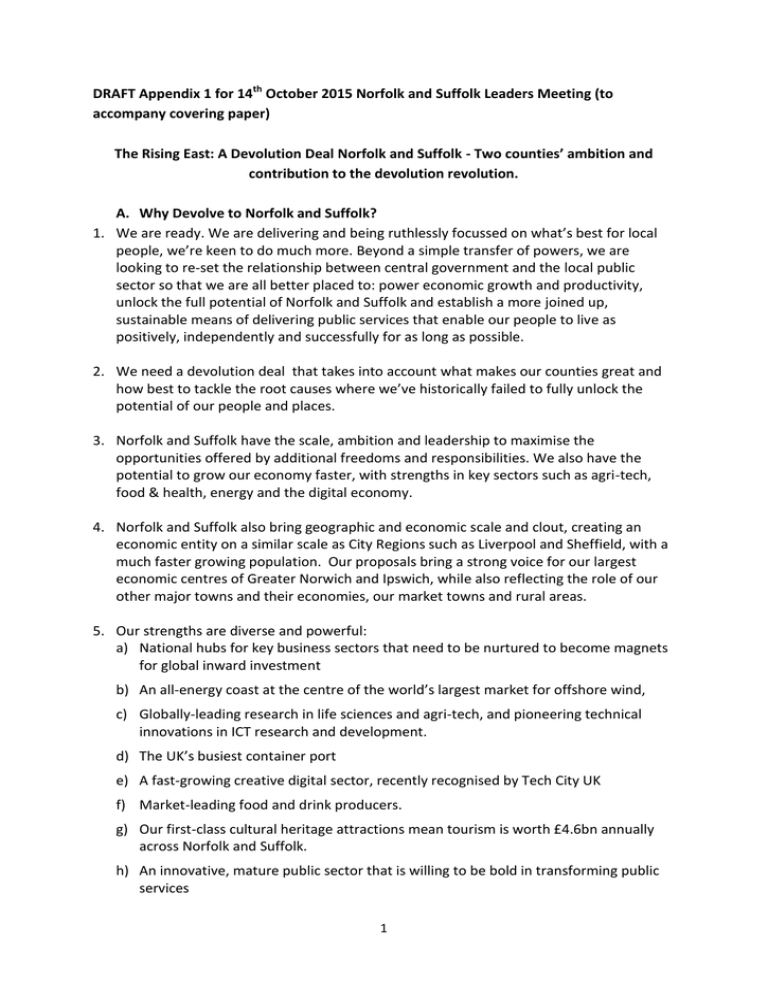DRAFT Appendix 1 for 14 accompany covering paper)
advertisement

DRAFT Appendix 1 for 14th October 2015 Norfolk and Suffolk Leaders Meeting (to accompany covering paper) The Rising East: A Devolution Deal Norfolk and Suffolk - Two counties’ ambition and contribution to the devolution revolution. A. Why Devolve to Norfolk and Suffolk? 1. We are ready. We are delivering and being ruthlessly focussed on what’s best for local people, we’re keen to do much more. Beyond a simple transfer of powers, we are looking to re-set the relationship between central government and the local public sector so that we are all better placed to: power economic growth and productivity, unlock the full potential of Norfolk and Suffolk and establish a more joined up, sustainable means of delivering public services that enable our people to live as positively, independently and successfully for as long as possible. 2. We need a devolution deal that takes into account what makes our counties great and how best to tackle the root causes where we’ve historically failed to fully unlock the potential of our people and places. 3. Norfolk and Suffolk have the scale, ambition and leadership to maximise the opportunities offered by additional freedoms and responsibilities. We also have the potential to grow our economy faster, with strengths in key sectors such as agri-tech, food & health, energy and the digital economy. 4. Norfolk and Suffolk also bring geographic and economic scale and clout, creating an economic entity on a similar scale as City Regions such as Liverpool and Sheffield, with a much faster growing population. Our proposals bring a strong voice for our largest economic centres of Greater Norwich and Ipswich, while also reflecting the role of our other major towns and their economies, our market towns and rural areas. 5. Our strengths are diverse and powerful: a) National hubs for key business sectors that need to be nurtured to become magnets for global inward investment b) An all-energy coast at the centre of the world’s largest market for offshore wind, c) Globally-leading research in life sciences and agri-tech, and pioneering technical innovations in ICT research and development. d) The UK’s busiest container port e) A fast-growing creative digital sector, recently recognised by Tech City UK f) Market-leading food and drink producers. g) Our first-class cultural heritage attractions mean tourism is worth £4.6bn annually across Norfolk and Suffolk. h) An innovative, mature public sector that is willing to be bold in transforming public services 1 6. We are proof that cross border collaboration can work. We already have an Enterprise Zone with sites in both counties, a cross border Clinical Commissioning Group that, through its joined up out of hospital team has improved patient satisfaction and reduced emergency admissions to hospital by over 10% in its first year bucking the national trend and winning the HSJ ‘improved partnerships between health and local government’ award last year; two City Deals for Norwich and Ipswich, a Local Transport Body and Skills Board led by the LEP including local councils and businesses. 7. Our Enterprise Zone in Great Yarmouth and Lowestoft has consistently been one of the country’s best performing zones, creating more than 1,300 jobs by May 2015 and £29m of private sector investment. We were the first EZ to introduce Local Development Orders on all our sites. 8. However, our ambitions have often been hampered by a lack of ability to influence the economic levers which accelerate the pace of growth. Our employment figures are among the best in the country, but our skills and productivity levels are below the national average. We need to tackle this problem head on, if we are to shift our economy to the next gear and compete and win on a global stage. 9. Growing the economy and improving productivity, underpinned by public service reform (particularly around the integration of health and social care), provides a framework to improve the opportunities and life chances for the people of Norfolk and Suffolk. B. The Norfolk and Suffolk approach 10. Our goal is to improve outcomes for local people. To do this we must increase our productivity – closing our GVA per head performance to the national average by 2020. This builds on our clear blueprint for growth as outlined in the New Anglia Strategic Economic Plan which will see 95,000 new jobs,10,000 new businesses, and 117,000 new houses. 11. We want to work more effectively together with Government to achieve a radically reset relationship between central and local public services and local people. One that is enabling and responsible; one that is adaptable and progressive and one that works in driving growth, enabling opportunity and delivering a more efficient public sector that influences better outcomes. 12. Firmly grounded in what’s best for local people, Norfolk and Suffolk’s approach to devolution is cross public sector and cross county with the ambition to both drive growth and public sector reform. Together we have the momentum to take our economy to the next level, maximise the potential for local business rate retention, create more effective, joined up public services and secure better outcomes for our people. To do this the Norfolk-Suffolk deal will be focussed on a number of key policy priorities: a) Productivity, business support and inward investment b) Housing and planning c) Assets and Infrastructure d) Education, employment and skills 2 e) Health and care redesign f) Blue light services g) Finance 13. All of the above will be supported by more locally autonomous, accountable, simpler, joined up governance that brings decision making closer to local people. We are clear that form must follow function and therefore, the getting the content of our negotiation right takes precedence over structures; however, we are ready to be radical and agreed a Combined Authority across Norfolk and Suffolk would fit with our principles of simpler, joined up, transparent decision making and subsidiarity – the right decision at the right level. C. Core Elements of the Norfolk-Suffolk proposal: 14. The following gives an overview of the most significant benefits and requests of Government across the policy priorities. These requests are a combination of transferring central control (of assets, funds and decisions) as well as a different ongoing way of working between central and local partners. 15. Whilst there is considerable detailed modelling behind the business cases that support each of the priority policy areas for the Norfolk-Suffolk proposal it can be characterised by the following changes in existing policy and benefits that will be unlocked as a result. Productivity, business support and inward investment 16. Productivity - Establish a Productivity Commission in order to look at improving productivity at the local level by understanding local root causes of productivity performance and implement a clear action plan of rapid change. This will require ongoing Government commitment to the Commission and use the Local Growth Fund to create a Productivity Fund to implement the Commission’s findings 17. Business Support - Build on the success of the Norwich and Ipswich City Deals that created the New Anglia Growth Hub to improve local business support. The Hub will have a key role in coordinating and delivering actions from the Productivity Commission and will offer more integrated, cost effective business support. It will also help improve alignment of economic development resources to maximise the impact of support for businesses. To support this we ask that Government devolve MAS & Growth accelerator funding into Growth Fund from 2017 (end of existing contract) and that £10m from Local Growth fund is used expand Growing Business Fund and create Productivity Fund – to be matched at least 4:1 by business levering and additional £40m investment. 18. Inward Investment - Develop the existing positive relationship with UKTI to improve inward investment through a whole system approach (using local assets better as well as working with UKTI). This would result in a coordinated inward investment service for Norfolk and Suffolk focussed on key locations and sectors, support to enable more businesses to export 19. Innovation – continue to invest in and align with national policy the local network of innovation centres and work with Government on an audit of science and innovation to 3 map and better maximise strengths and assets. In return we would want New Anglia area and neighbours to be included in the first round of science and innovation audits and Government commitment to invest in local assets as a result. 20. European Structural Funds –work with Government to identify opportunities to devolve European Structural Funds including granting of intermediate body status for notional allocation. Coherent Housing and Planning 21. Joint Strategic Plan supported by local delivery plans - a strategic plan that aligns and integrates all the different strategies and is supported by local delivery plans so that decision making on developments can be made closer to the communities they are part of. 22. New Settlements - Working with Government to identify new settlements /garden cities with Homes and Communities Agency 23. Planning reform pathfinder – to work with Government and the sector to radically rethink the local plan process to maintain an up to date land supply, provide certainty for developers and reduce the necessity for systematic local plan reviews Assets and Infrastructure 24. Funding - Devolve funding and decision making with a 5-10 year settlement incorporating capital funding (eg, local transport plan and Growth Deal) and revenue support in local transport to enable the development of a modern transport system with a secure future based on local economic priorities including developing employment and housing sites across the counties 25. Strategic Transport Networks - Greater local engagement and influence over planned improvements to the Strategic Road Network, and the development of rail franchises and rail infrastructure programmes of spend. We would want to explore with Government the role that a Combined Authority could take in decision making with key strategic bodies such as Network Rail and the Highways Agency. 26. Flooding – support from government for a joined up approach to flood management and coastal defences, forging a new partnership with the Environment Agency to pool funding and resources for coastal defences and flood management. 27. Utilities and Energy – shaping and influencing the priorities for utilities to support growth in key locations in anticipation of planned growth. We would like to explore a pilot bringing together utility providers with developers and the combined authority to provide upfront funding to overcome blockages to development caused by lack of suitable utility provision. 28. Public Transport - The ability to allow user contributions for concessionary passes and local discretion to vary the age threshold on disabled eligibility. 4 Education, employment and skills 29. Post 16 education and skills provision - The power to co commission with Government all post 16 education and skills provision and agree a rolling 3 year notional allocation of post 16 education and skills funding through outcome based agreements 30. Schools Planning - The ability to establish, with the Regional Schools Commissioner (RSC), a single entity for schools planning and accountability which ensures that together we are taking the right action for all schools in New Anglia to be ‘Good’ or ‘Outstanding’ by 2017. 31. Joint Education Infrastructure Plan – working with DfE and the RSC to enable us to collectively meet the demands of our growing population and delivers the maximum number of school places with the available resources. 32. New Anglia Youth Pledge - Establish a sustainable New Anglia Youth Pledge delivered through a shared investment model with Government 33. Institutes of Technology – a 5 year allocation of skills capital to establish a network of Institutes of Technology and ability to co-design the Institutes of Technology model and invite our highest performing Colleges to convert to Institutes of Technology to deliver high standard provision at levels 3, 4 and 5 in our priority sectors. 34. Apprenticeship levy – work with the Government to design an Apprenticeship levy system which works at local level and ensures no business is left behind by the reforms 35. Employment Support Allowance – provided a more effective, integrated support offer to help people improve their employment opportunities. Ways we would like to do this include working with DWP to trial a new delivery model of employment support and coinvestment in the staged roll out of the success elements of this new approach. 36. Novation of the National Careers Service contract to the local area and the commitment to local co-commissioning for Work Programme Plus and other nationally procured employment programmes to ensure they build on what works locally. Health and care redesign 37. Funding – Optimise resources across the local system through a more integrated, medium term approach to financial planning that enables a shift to models of prevention and early help to enable independence and reduce demand. This would require Government to devolve multi-year settlements for health, care and safety. 38. Estates – local control over public service estates and capital assets including NHS and police to unlock assets across local public services. 39. Changing model of support – explicit support from Government departments, inspectorates and regulators to enable longer term systemic shifts in service delivery 5 Blue Light 40. Firmly rooted in the wider public service reform, the need to collaborate and encourage preventative and early help work to reduce demand are key elements for the ‘blue light’ services in Suffolk and Norfolk. Greater funding certainty and local control over resources along with simpler governance will enhance current direction of travel for our blue light services. Finance 41. Underpinning all elements of the Norfolk-Suffolk proposal, greater local autonomy over resources is absolutely critical to the success of the proposal. We are seeking a radically different approach to local public service funding, where greater local autonomy creates a system that is more locally self-sufficient than reliant on central grants. This certainty and increased local autonomy would enable more rational and medium term planning across local public resources. More flexibility is required to deliver our ambitions and manage the risks we are taking on. 42. We want to work with government to develop this model which will require a new relationship with Government to ensure that the different arrangements for monitoring, presenting and assuring Suffolk’s budgets are clear, accountable and manage risk. 43. There are a number of areas (some more specific to policy areas) that we would wish to explore in developing the financial model: a) 100% Retention of Business Rates b) 100% Retention of Business Rates Growth c) Freedom to set the Business Rates Multiplier and an y discounts d) Increase referendum limits for Council Tax setting to 5% e) Freedom to set all discounts and allowances in the Council Tax system f) Full discretion to set all fees and charges locally g) Negotiate the continuation of New Burdens funding for those new duties and activities which government may impose on local public services from time to time h) Certainty over New Homes Bonus i) Have first rights on central government estates in Suffolk and Norfolk in addition to our health, care and safety proposal for local autonomy over all (including NHS) local public sector estates would provide more opportunity to unlock sites for employment and housing as well as smarter use of public assets 6

